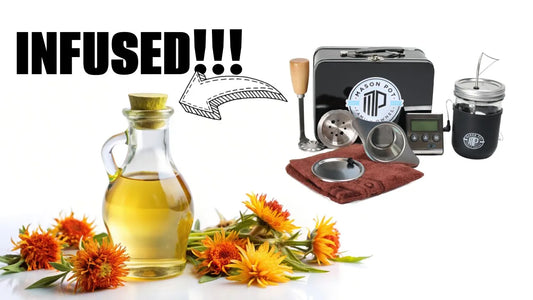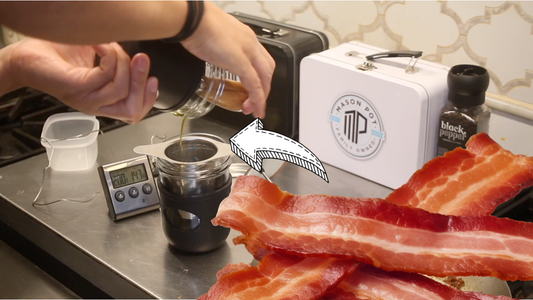Welcome to the Mason Pot family! Today, we're diving deep into the world of cannabis decarboxylation using a method that's both efficient and energy-saving: the residual heat technique. This method not only simplifies the process but also ensures that you get the most out of your cannabis with minimal effort. Let's get started!
Understanding the Residual Heat Decarboxylation Method
Decarboxylation is a crucial process for activating the psychoactive and therapeutic properties of cannabis. Typically, this involves heating cannabis to a specific temperature to convert THCA into THC, the compound responsible for cannabis' psychoactive effects. However, today we're exploring a less conventional, yet highly effective method known as residual heat decarboxylation.
Step-by-Step Guide to Residual Heat Decarboxylation
- Preheat Your Oven: Set your oven to 250°F. Our oven options are limited to 225°F and 250°F, so we'll opt for the higher setting to ensure we reach our target temperature effectively.
- Prepare Your Cannabis: Place your cannabis in a Mason jar. This jar will not only contain the cannabis but also help in evenly distributing the heat during the decarboxylation process.
- Heat the Cannabis: Once the oven is preheated, place the Mason jar in the center of the oven. Close the door and let the cannabis heat until the oven thermometer reads 240°F.
- Turn Off the Oven: As soon as the desired temperature is reached, turn off the oven. The key to the residual heat method is to let the cannabis sit in the oven as it slowly cools down. This utilizes the retained heat to continue the decarboxylation process without additional energy.
- Monitor the Temperature: Keep an eye on the oven thermometer. If the temperature starts to drop below the desired range, you can briefly turn the oven back on to a lower setting (around 200°F) to bring it back up before turning it off again.
- Let It Rest: Allow the cannabis to sit in the oven for about 40 minutes, or until the oven has cooled significantly. This slow cooling process helps in achieving a thorough decarboxylation.
Why Choose the Residual Heat Method?
The residual heat method offers several benefits:
- Energy Efficiency: By utilizing the residual heat of the oven, this method conserves energy that would otherwise be used to maintain a constant temperature.
- Even Heating: The gradual decrease in temperature allows for more even heating, reducing the risk of overheating the cannabis which can lead to loss of potency.
- Convenience: This method is relatively hands-off, requiring less monitoring and adjustment once the initial temperature is reached.
Tips for Success
- Use an Oven That Retains Heat Well: To effectively use the residual heat method, you need an oven that maintains temperature well after being turned off.
- **Monitor Closely**: Keep a close eye on the temperature throughout the process. This ensures that the cannabis is not under or over-decarboxylated.
- Use a Thermometer: A reliable oven thermometer is crucial for this method. It helps in accurately gauging the internal temperature of the oven and making necessary adjustments.
- Be Patient: The key to successful residual heat decarboxylation is patience. Allow the process to unfold slowly to achieve the best results.
Exploring the Benefits of Residual Heat
The residual heat method is not just about saving energy; it's also about precision and maintaining the integrity of your cannabis. By allowing the cannabis to slowly decarboxylate at a controlled temperature, you minimize the risk of losing essential cannabinoids and terpenes, which can evaporate at higher temperatures. This method ensures that you preserve these important compounds, resulting in a more potent and flavorful product.
Real-Life Application and Results
During our experiment, the oven was preheated to 250°F and then turned off once the cannabis reached 240°F. The temperature was maintained well within the desired range for the duration of the process, only dropping a few degrees towards the end. This stability is a testament to the effectiveness of using residual heat for decarboxylation.
Additional Uses: Infusing Oils and Butters
Interestingly, the residual heat method can also be applied to the infusion of oils and butters with cannabis. The process is similar: once your cannabis is decarboxylated, you can add your oil or butter to the Mason jar and let it sit in the residual heat of the oven. This gentle heating allows the cannabinoids to infuse into the fat without the risk of overheating, which can degrade the quality of your infusion.
Your use of any information or materials on this channel is entirely at your own risk, for which Mason Pot shall not be liable. By entering this channel, you expressly agree to indemnify and hold harmless Mason Pot and any person, entity, associate, or party affiliated with MasonPot from any and all loss, liability or damages incurred as a result of your use of this site/ channel.




